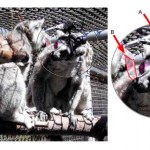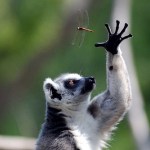Lemur
Behold! The second installment of the Science Online Lemur Cognition series. If you missed the first installment, you should check out the cyborg lemurs of the Duke Lemur Center.
There's some pretty good evidence that numerical cognition emerged fairly early in the primate lineage, at least, if not significantly earlier in evolution. Most of the work on numerical cognition in non-human primates, however, has focused on a handful of monkey and ape species. The prosimian suborder of primates, however, which includes lemurs, diverged from the main primate lineage some 47-54 million years ago. If…
In honor of Science Online, which begins on Thursday night, I will be writing about lemurs this week. Why lemurs? Because on Friday morning, as a part of Science Online, I will be taking a tour of the Duke Lemur Center.
It is common among animals - especially primates - to orient their gaze preferentially towards other individuals, as well as to follow the gaze of others. Lots of attention has been paid to gaze-following, in part because the ability to recognize and orient to the behavior of others is missing or impaired in various developmental disorders, such as autism. It is well known…
"Dinah", a young female gorilla kept at the Bronx Zoo in 1914. From the Zoological Society Bulletin.Frustrated by the failure of gorillas to thrive in captivity, in 1914 the Bronx Zoo's director William Hornaday lamented "There is not the slightest reason to hope that an adult gorilla, either male or female, ever will be seen living in a zoological park or garden." Whereas wild adult gorillas were "savage" and "implacable" beasts which could not be captured (a photo of a sculpture included in Hornaday's article depicts a gorilla strangling one man, brandishing another about with its other arm…
A baby Coquerel's sifaka (Propithecus coquereli), photographed at the Bronx Zoo.
A grey mouse lemur (Microcebus murinus). Image from Wikipedia.
Charles Darwin's visit to the Galapagos Archipelago has been celebrated time and again for its influence on his evolutionary thoughts, but I have to wonder what would have happened if the Beagle skipped the Galapagos and visited Madagascar instead. What would Darwin have made of the animals which had been evolving in splendid isolation on the African island? Would "Darwin's lemurs", rather than Darwin's finches, be among the most recognizable icons of evolution?
Answers to such questions are beyond our grasp, but the diverse array…
Research on the subject suggests that somewhere, somehow our squirmy reaction to incest can be expressed genetically. Because of natural selection and all that blah blah, it's thought that there exists a biomechanism that triggers incest avoidance in humans. Well, it looks like some very bold scientists have found a solid starting point for furthur research: lemur hoo-ha's.
Christine Drea, Marylene Boulet, and Marie Charpentier from Duke University carefully obtained genital gland secretions from 17 sexually mature female ring-tailed lemurs.Side note: most species of lemurs live in…
If you are unfamiliar with South Korea's Everland Zoo and their ridiculously talented photographer who goes by FloridaPFE on Flickr, time to make a new friend.
Studying the way an animal moves by looking at its ears might seem like a poorly thought-out strategy. After all, short of watching it directly, most biologists would choose to look at more obvious traits like tracks, or limb bones.
But while an animal's limbs may drive it forward, its inner ear makes sure that it doesn't immediately fall over. By controlling balance, it plays a key role in movement, and its relative size can tell us about how agile an animal is.
When we walk, the image that forms on our retinas changes quite considerably. But no matter how fast or erratically we move, our…
Apologies for overloading cute on you all. These baby lemurs were recently born at Folly Farm Zoo in Pembrokeshire, Wales.
Rejected by his parents at birth, Bilbo the bamboo lemur was raised by hand by zookeeper Veronica Lindberg. As a result, Bilbo thinks he is a human and refuses to leave Veronica's side. Clinging to her back, wrapped around her arm or perching on her head, the two are inseparable. Raising Bilbo is no easy task as he must be fed once an hour, every hour. His photogenic furriness has made him a media darling in Sweden, although the country's hopes of dethroning Germany's nauseatingly adorable polar bear cub, Knut, are misplaced.
Bilbo shows-off "Blue Steel". Bamboo Lemur, genus Hapalemur
We…


